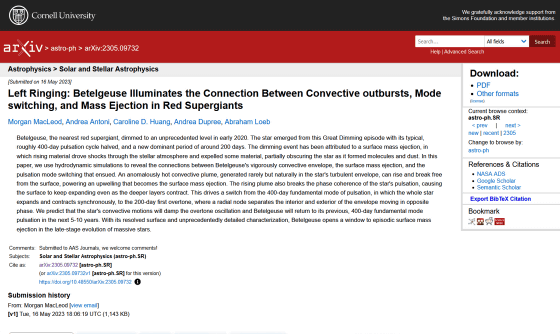Research results that the red supergiant `` Betelgeuse '' shining on the right shoulder of Orion changed its brightness fluctuation period after it became dark in 2019

by
Betelgeuse, which is located on the right shoulder of Orion (upper left as viewed from Earth) and is also one of the Great Winter Triangles , is a pulsating variable star whose brightness fluctuates periodically. Such Betelgeuse became significantly darker in the latter half of 2019 , and it was said that 'it may be a sign of a supernova explosion.' At the time of writing the article, the brightness of Betelgeuse has been picking up, and researchers report that ``the period in which Betelgeuse's brightness fluctuates has changed.''
[2305.09732] Left Ringing: Betelgeuse Illuminates the Connection Between Convective outbursts, Mode switching, and Mass Ejection in Red Supergiants
https://doi.org/10.48550/arXiv.2305.09732

Betelgeuse Is Being Weird Again. What Gives?
https://www.sciencealert.com/betelgeuse-is-being-weird-again-what-gives
'It's new territory': why is Betelgeuse glowing so brightly and behaving so strangely? | Astronomy | The Guardian
https://www.theguardian.com/science/2023/may/26/its-new-territory-why-is-betelgeuse-is-glowing-so-brightly-and-behaving-so-strangely
Betelgeuse is one of only 21 first-magnitude stars in the sky, and is the largest red supergiant star visible to the naked eye. If Betelgeuse is placed at the center of the solar system, its edge is large enough to exceed the orbit of Jupiter.
In the fixed star, synthesis by nuclear fusion ( intrastellar nucleosynthesis ) is performed from light elements to heavy elements, first nuclear fusion by hydrogen is performed, then helium nuclear fusion, and then reaction to carbon and oxygen advances. Betelgeuse is believed to be in the stage where helium fusion is occurring at the center of the star, and it is believed that there is a high possibility that the fuel will run out and cause a supernova explosion within 100,000 years.
In December 2019, it was reported that the brightness of Betelgeuse was about half compared to October, and it was the lowest in observation history, so it was said that it was a sign of a supernova explosion. , and it is reported that Betelgeuse's brightness returned again after that.
Betelgeuse, which was thought to be on the verge of a supernova explosion, is picking up - GIGAZINE

Subsequent research has suggested that the large-scale dimming that occurred at Betelgeuse was due to the simultaneous occurrence of a temporary temperature drop and interstellar dust . According to this theory, cold spots appeared on Betelgeuse's surface, darkening those areas, and at the same time, the dust formed on the spots fell between the Earth and Betelgeuse, causing Betelgeuse's brightness as seen from Earth. is said to have decreased.
Is the cause of 'Great dimming of Betelgeuse' 'temperature drop and interstellar dust'-GIGAZINE

The brightness of Betelgeuse will gradually increase from 2022 to 2023, reaching 156% of its normal brightness in April 2023, and 142% brighter than normal as of May. . As a result, it seems that Betelgeuse, which was originally the 10th brightest in the whole sky, is now the 7th brightest in the whole sky.
Now at 142% of my usual brightness! #Betelgeuse pic.twitter.com/S7TuFTcjdj
—Betelgeuse Status (@betelbot) May 18, 2023
Newly, the research team at the Harvard-Smithsonian Center for Astrophysics published a paper on the preprint server arXiv, and announced the research results that ``Betelgeuse changed its brightness fluctuation period after a large dimming.''
Betelgeuse was originally a pulsating variable star that fluctuated between bright and dark periods in a cycle of about 400 days, but at the time of writing the article, the fluctuation period was about half, about 200 days. This cycle is thought to be fluctuating due to expansion and contraction inside Betelgeuse, and it is expected to return to the original 400-day cycle over the next 5 to 10 years.
'One of the coolest things about Betelgeuse is that we can see the final stages of the evolution of large stars in near real time,' said Dr. Sarah Webb, an astrophysicist at Swinburne University of Technology in Australia. The increase and decrease of light is entering a new realm that we have not yet seen.'

Related Posts:
in Science, Posted by log1h_ik





